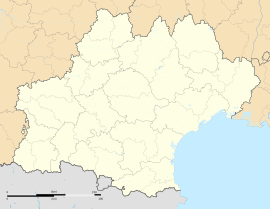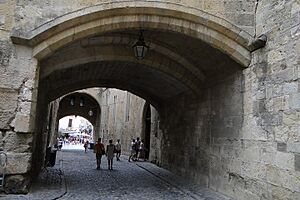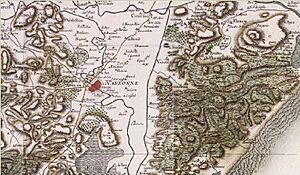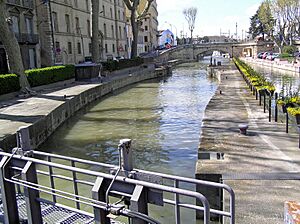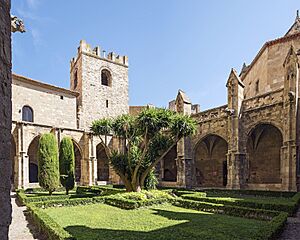Narbonne facts for kids
Quick facts for kids
Narbonne
Narbona (Occitan)
|
|||
|---|---|---|---|
|
Subprefecture and commune
|
|||
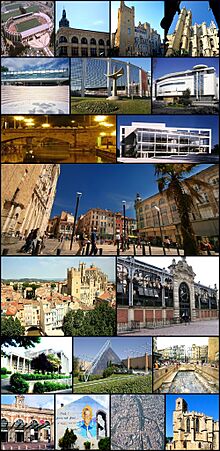
From left to right, top to bottom: The Parc des Sports et de l'Amitié stadium; historic department store Aux Dames de France; the Archbishop's Palace; Saint-Just-et-Saint-Pasteur Cathedral; the Médiathèque library and multi-media center; a sculpture on the stadium grounds; the Hall of Justice; Voltaire Bridge; the Narbonne Théâtre; City Hall square; Merchants' Bridge with a view of the Archbishop's Palace; the Cathedral and the Canal de la Robine; Les Halles covered market; the Palais des Sports, des Arts et du Travail sports, arts and work complex; the Espace de Liberté multi-use center; the Via Domitia; the Narbonne train station; Charles Trenet, born in Narbonne; an aerial view of the city center; former church Notre-Dame de Lamourguier, now the Lapidary Museum
|
|||
|
|||
| Country | France | ||
| Region | Occitanie | ||
| Department | Aude | ||
| Arrondissement | Narbonne | ||
| Canton | Narbonne-1, 2 and 3 | ||
| Intercommunality | Grand Narbonne | ||
| Area
1
|
172.96 km2 (66.78 sq mi) | ||
| Population
(2021)
|
56,395 | ||
| • Density | 326.058/km2 (844.49/sq mi) | ||
| Demonym(s) | Narbonnese (en) narbonnaise (fr) |
||
| Time zone | UTC+01:00 (CET) | ||
| • Summer (DST) | UTC+02:00 (CEST) | ||
| INSEE/Postal code |
11262 /11100
|
||
| Elevation | 0–285 m (0–935 ft) | ||
| 1 French Land Register data, which excludes lakes, ponds, glaciers > 1 km2 (0.386 sq mi or 247 acres) and river estuaries. | |||
Narbonne is a city in Southern France. It is in the Occitanie region and the Aude department. Narbonne is about 849 kilometers (528 miles) from Paris. It is also about 15 kilometers (9 miles) from the Mediterranean Sea. Long ago, it was a busy port city.
Narbonne's importance decreased after the 14th century. This happened because the Aude river changed its path. Narbonne is the largest city in the Aude department. However, the capital city of Aude is Carcassonne, which is smaller.
Contents
What's in a Name?
The first name for the town was Narbo. No one knows for sure where this name came from. It might have been the name of an old hillfort from the Iron Age. This fort was near where Narbonne is today.
The Greek writer Hecataeus of Miletus wrote about the area in the 5th century BC. He said it was a Celtic port and market. He called the people who lived there Ναρβαῖοι. Sometimes, the name was written in Latin. Other times, it was translated into Iberian as Nedhena.
Narbonne's Past
Under the Romans
Narbonne was founded by the Roman Republic in 118 BC. Its full name was Colonia Narbo Martius, but people often called it Narbo. It became the capital of a new Roman province called Gallia Transalpina.
The city was built on the Via Domitia. This was the first Roman road in Gaul (ancient France). It connected Italy to Spain. Narbonne was a very important crossroads. The Via Domitia met the Via Aquitania here. The Via Aquitania led to the Atlantic Ocean through cities like Toulouse and Bordeaux. The Aude river also flowed through Narbonne.
Julius Caesar gave land in Narbonne to his soldiers. These soldiers were from his 10th Legion. Narbonne became a rival to Massilia (modern Marseille). Caesar wanted to make Narbonne's port bigger. This was because Marseille supported his enemy, Pompey. Narbonne was also famous for its rosemary-flower honey among the Romans.
Later, the province of Gallia Transalpina was renamed Gallia Narbonensis. Narbonne became its capital. The city grew a lot in wealth and buildings. At that time, Narbonne might have had 30,000 to 50,000 people. Some even think it had as many as 100,000.
Under the Visigoths
In 462, Narbonne was given to the Visigoths. This marked the end of Roman rule in the city. Narbonne then became the capital of Septimania. This was the only part of Gaul that the Franks could not conquer after the Battle of Vouille in 507.
In 531, the Frankish king, Childebert I, attacked Septimania. He defeated the Visigothic king, Amalaric, near Narbonne and took the city. But Childebert's attack on Catalonia failed. So, Amalaric's successor, Theudis, got Septimania and Narbonne back. The last two Visigothic kings, Agila II and Ardo, moved to Narbonne in 711/712. They fought off Muslim attacks until 716.
Under the Arabs
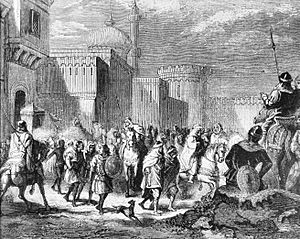
Narbonne was part of the Umayyad Caliphate for 40 years, from 719 to 759. The Umayyad governor Al-Samh captured Narbonne from the Visigothic Kingdom in 719.
Under the Carolingians
The Carolingian king Pepin the Short took Narbonne from the Arabs in 759. After this, it became part of the Viscounty of Narbonne. Pepin invited important Jews from the Abbasid Caliphate in Baghdad to live in Narbonne. He wanted them to create a major Jewish learning center there.
In the 12th century, Ermengarde of Narbonne ruled the city. Her court was a cultural hub. It was a place where the idea of courtly love grew. A historian named Arthur J. Zuckerman wrote a book in 1973. He suggested there was a Jewish princedom in Narbonne from the 8th to 10th centuries. He said Pepin gave it to the Jews as a thank you for their help. However, other historians do not agree with this idea.
Under the Capets
In the 11th and 12th centuries, Narbonne had an important Jewish school. This school helped develop the Zarphatic (Judæo-French) and Shuadit (Judæo-Provençal) languages. Jews had lived in Narbonne since about the 5th century. By the 12th century, there were about 2,000 Jewish people. Narbonne was often mentioned in Talmudic writings because of its scholars. One writer, Abraham ibn Daud, said they were as important as the leaders in Babylon. The Jewish community faced good and bad times. Then, it slowly declined in the 12th and 13th centuries.
Narbonne Loses its River and Port
Narbonne began to decline in the 14th century. There were several reasons for this. One big reason was a change in the Aude river. This caused too much silt to build up, making it hard for ships to reach the port. The river used to have two main paths. The Romans had made the river easier to use by building a dam. They also built a canal through its marshy area to the sea. This canal is still called the Robine.
A big flood in 1320 washed the dam away. The Aude river often flooded. When Narbonne was a busy port, it was about 5 to 10 kilometers (3 to 6 miles) from the coast. But ships could only reach the port when the river was full. This made travel between the port and city unreliable. However, goods could still be moved by land or in small boats.
Changes to the coastline also hurt the port. The openings between the islands along the shore became blocked with silt. Other problems included the plague and an attack by Edward, the Black Prince. The growth of other ports also played a role in Narbonne's decline.
Narbonne Cathedral
Narbonne Cathedral is dedicated to Saints Justus and Pastor. It shows how Narbonne's luck changed quickly. The back of the cathedral shows a huge building project that was never finished. It is still one of the tallest cathedrals in France.
There were many reasons it was not finished. The main reason was that the completed cathedral would have meant tearing down the city wall. The 14th century also brought the plague. This made people want to keep the old 5th-century walls for protection.
Still, the choir, side chapels, sacristy, and courtyard are complete. The cathedral is no longer the main church for a bishop. But it is still the main place of worship for Catholics in the city. It is also a popular place for tourists to visit.
Building the Canal de la Robine
Starting in the 16th century, people in Narbonne wanted to keep their trade links. They began expensive work on the Aude river's path to the sea. They wanted it to stay open for smaller boats. They also wanted it to connect to the Royal Canal. This big project led to the building of the Canal de la Robine. It finally connected to the Canal du Midi (then called the Royal Canal) in 1776. This connection was made through the Canal de Jonction.
In the 19th century, canals in southern France faced competition. A growing rail network could ship goods faster. The canals still kept some importance. They were used to support the booming wine trade. Even after its decline from Roman times, Narbonne kept its important, though limited, role as a trade route. This has continued in recent centuries.
Where is Narbonne?
Narbonne is connected to the nearby Canal du Midi and the Aude river. This connection is made by the Canal de la Robine, which flows through the city center. It is very close to the A9 motorway. This road links Montpellier and Nîmes to Perpignan. It also goes across the border to Barcelona in Spain.
Narbonne also has a recently updated train station. You can take high-speed trains (TGV) to Spain, Paris, and Calais. From Calais, you can connect to the Eurostar. Narbonne is only 10 kilometers (6 miles) from Narbonne Plage (beach). It is just 2 kilometers (1.2 miles) from the closest open water at La Nautique. However, La Nautique has pebbles, not sand.
Climate
| Climate data for Narbonne | |||||||||||||
|---|---|---|---|---|---|---|---|---|---|---|---|---|---|
| Month | Jan | Feb | Mar | Apr | May | Jun | Jul | Aug | Sep | Oct | Nov | Dec | Year |
| Record high °C (°F) | 22.8 (73.0) |
23.3 (73.9) |
28.6 (83.5) |
31.0 (87.8) |
33.9 (93.0) |
38.8 (101.8) |
38.8 (101.8) |
42.1 (107.8) |
36.9 (98.4) |
32.7 (90.9) |
25.6 (78.1) |
22.5 (72.5) |
42.1 (107.8) |
| Mean daily maximum °C (°F) | 10.9 (51.6) |
12.1 (53.8) |
15.5 (59.9) |
18.1 (64.6) |
21.8 (71.2) |
26.4 (79.5) |
29.3 (84.7) |
29.1 (84.4) |
24.9 (76.8) |
19.9 (67.8) |
14.6 (58.3) |
11.5 (52.7) |
19.5 (67.1) |
| Daily mean °C (°F) | 7.8 (46.0) |
8.4 (47.1) |
11.3 (52.3) |
13.6 (56.5) |
17.2 (63.0) |
21.3 (70.3) |
24.0 (75.2) |
23.9 (75.0) |
20.2 (68.4) |
16.2 (61.2) |
11.4 (52.5) |
8.5 (47.3) |
15.3 (59.5) |
| Mean daily minimum °C (°F) | 4.7 (40.5) |
4.7 (40.5) |
7.1 (44.8) |
9.1 (48.4) |
12.6 (54.7) |
16.2 (61.2) |
18.6 (65.5) |
18.6 (65.5) |
15.5 (59.9) |
12.5 (54.5) |
8.2 (46.8) |
5.5 (41.9) |
11.1 (52.0) |
| Record low °C (°F) | −4.7 (23.5) |
−8.1 (17.4) |
−5.2 (22.6) |
0.3 (32.5) |
2.2 (36.0) |
8.7 (47.7) |
11.2 (52.2) |
11.8 (53.2) |
7.8 (46.0) |
2.0 (35.6) |
−3.9 (25.0) |
−6.0 (21.2) |
−8.1 (17.4) |
| Average precipitation mm (inches) | 61.4 (2.42) |
46.5 (1.83) |
48.2 (1.90) |
63.6 (2.50) |
51.3 (2.02) |
32.5 (1.28) |
17.0 (0.67) |
31.1 (1.22) |
60.6 (2.39) |
92.5 (3.64) |
78.4 (3.09) |
52.2 (2.06) |
635.3 (25.01) |
| Average precipitation days (≥ 1.0 mm) | 5.9 | 4.9 | 5.9 | 6.4 | 6.1 | 3.7 | 2.6 | 3.6 | 4.5 | 5.9 | 5.7 | 5.5 | 60.6 |
| Average relative humidity (%) | 83.06 | 81.28 | 78.36 | 75.05 | 75.9 | 73.15 | 68.07 | 66.94 | 70.85 | 78.35 | 83.59 | 83.34 | 76.50 |
| Mean daily sunshine hours | 4 | 6 | 8 | 8 | 8 | 10 | 11 | 9 | 8 | 6 | 5 | 4 | 7.25 |
| Source 1: Meteo France; Holiday-Weather.com | |||||||||||||
| Source 2: Weather and Climate | |||||||||||||
| Month | Jan | Feb | Mar | Apr | May | Jun | Jul | Aug | Sep | Oct | Nov | Dec | Year |
|---|---|---|---|---|---|---|---|---|---|---|---|---|---|
| Average sea temperature °C | 13 | 13 | 13 | 14 | 16 | 19 | 22 | 23 | 21 | 18 | 16 | 14 | 16.8 |
| Average Wind Speed km/h | 20.9 | 21.2 | 20.9 | 20.5 | 19.4 | 19.1 | 19.8 | 18.0 | 17.3 | 17.6 | 19.8 | 19.4 | 19.4 |
| Source: holiday-weather.com; Meteo France | |||||||||||||
How Many People Live Here?
| Historical population | |||||||||||||||||||||||||||||||||||||||||||||||||||||||||||||||||||||||||||||||||||||||||||||||||||||||||||||||||||
|---|---|---|---|---|---|---|---|---|---|---|---|---|---|---|---|---|---|---|---|---|---|---|---|---|---|---|---|---|---|---|---|---|---|---|---|---|---|---|---|---|---|---|---|---|---|---|---|---|---|---|---|---|---|---|---|---|---|---|---|---|---|---|---|---|---|---|---|---|---|---|---|---|---|---|---|---|---|---|---|---|---|---|---|---|---|---|---|---|---|---|---|---|---|---|---|---|---|---|---|---|---|---|---|---|---|---|---|---|---|---|---|---|---|---|---|
|
|
||||||||||||||||||||||||||||||||||||||||||||||||||||||||||||||||||||||||||||||||||||||||||||||||||||||||||||||||||
| Source: EHESS and INSEE (1968–2017) | |||||||||||||||||||||||||||||||||||||||||||||||||||||||||||||||||||||||||||||||||||||||||||||||||||||||||||||||||||
Places to See
- The cathedral was built starting in 1272.
- The Palais des Archevêques, or Archbishop's Palace, has a tall tower. You can get great views of Narbonne from it.
- The Musée Archeologique is an archaeological museum. It is in the city center. (Note: This museum was closed in November 2019. Most items will move to a new museum called Narbo Via, which opened in September 2020.)
- Clos de la Lombarde is an archaeological site. You can see remains of Roman homes, bath houses, and workshops there. These date from the 1st century BC to the 3rd century AD. It also has the first Christian church in Narbonne (3rd/4th century AD).
- The Roman Horreum was an underground grain warehouse.
- You can still see parts of the Via Domitia in the city center.
- The Canal de la Robine runs through the middle of the town.
- The Halles is a covered market that is open every day. It is busiest on Sunday and Thursday mornings.
- The nearby limestone hills are called La Clape. You can also visit the beach at Narbonne plage.
Sports
Narbonne has a rugby union team called RC Narbonne. It was started in 1907. This team is famous in France. Narbonne has won the French first division title twice. They also reached a European final in 2001. They play at the Parc des Sports Et de l'Amitié stadium, which can hold 12,000 people. Their team colors are orange and black.
Getting Around
The Gare de Narbonne train station offers direct trains. You can go to Paris, Barcelona, Toulouse, and Marseille. There are also many trains to other places in the region. Narbonne has a good system of buses and routes. These are run by Citibus.fr. They make it easy to travel within Narbonne and nearby towns. Narbonne does not have its own airport. So, travelers usually fly into airports in nearby cities. These include Béziers, Carcassonne, Perpignan, Toulouse, or Montpellier.
Famous People from Narbonne
- Varro Atacinus, a Roman poet
- Ateyaba, a French hip-hop artist
- Alexandre Baron, a racing driver
- Joseph Barsalou (physician) (1600–1669), a doctor whose family was from Narbonne
- Kalonymus ben Todros (died around 1194), a rabbi from Provence
- The rabbinic family of Benveniste
- Léon Blum was born in Paris. But he was elected as a representative for Narbonne in 1929, 1932, and 1936.
- Bonfilh, a Jewish poet and musician (troubadour) from the city
- Carus, a Roman emperor from 282 to 283
- Guillaume Barthez de Marmorières (1707–1799), a civil engineer
- Camille Lacourt, a world champion swimmer
- Benjamin Lariche, a racing driver
- Makhir of Narbonne, a medieval Jewish scholar
- Jean-Joseph Cassanéa De Mondonville (1711–1772), a violinist and composer
- Moshe ha-Darshan (11th century), head of the Jewish school in Narbonne
- Anaïs Napoleón, a French-Spanish photographer
- Pierre Reverdy, a surrealist poet
- Saint Sébastien, a Christian saint and martyr from the 3rd century
- Dimitri Szarzewski, a rugby player
- Charles Trenet, a singer-songwriter
Sister Cities
Narbonne is connected with these cities around the world:
See also
 In Spanish: Narbona para niños
In Spanish: Narbona para niños





